|
|
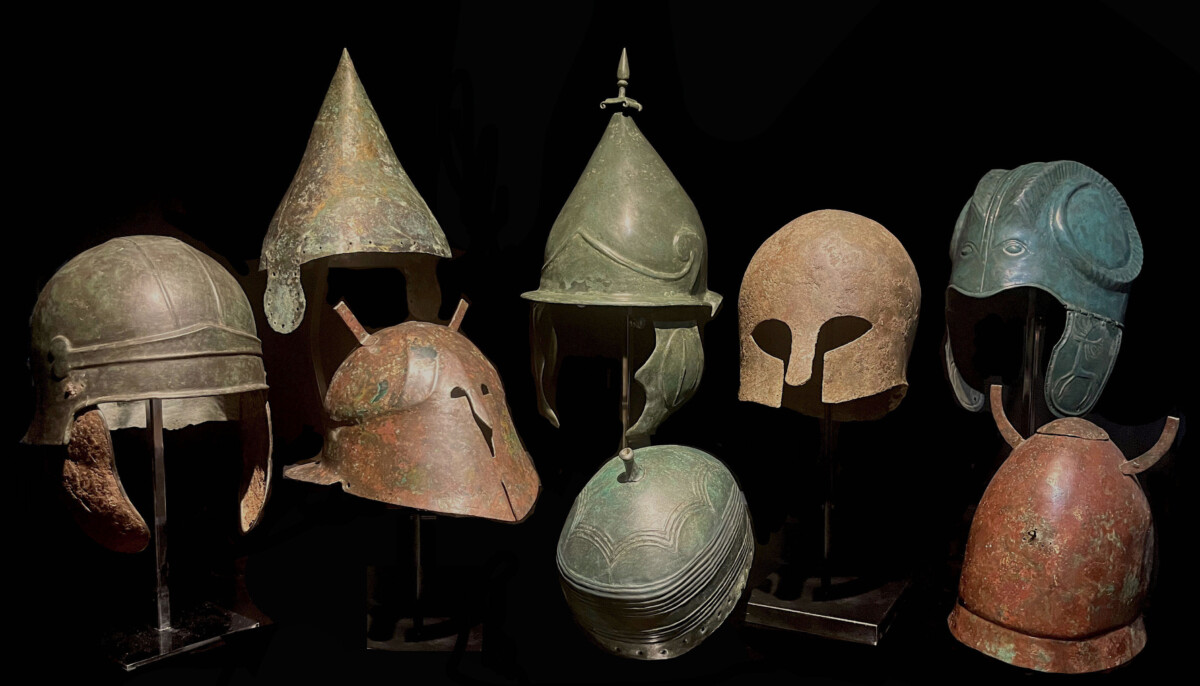
|
"Hoplites and Legionnaires" – Our Major Spring Exhibition on March 9 in Vienna
|
|
Come and join us: On March 9 at 6 p.m. we invite you to the opening of our major spring exhibition "Hoplites and Legionnaires" in our showroom in Vienna. We show no less than eight ancient helmets (photo above) – from the Bronze Age to the Roman Empire, from Alexander to Xerxes. We also present rare military diplomas from soldiers that were the pride of Rome. And we look with wink and admiration at masterpieces such as the Mars Ultor, who embodied the glory and strength of the Eternal City. You can find the invitation here. We are looking forward to your visit!
|
ART & ANTIQUE Salzburg from 1 to 10 April. We are also looking forward to participating at the first major art fair of the year in a month's time. The ART & ANTIQUE Residenz Salzburg takes place in parallel to the "Salzburger Osterfestspiele". As the sole gallery for ancient art we will exhibit numerous masterpieces, amongst them a black-figure amphora of the Leagros Group and a Corinthian helmet from the Archaic Period. See you soon – at Easter in Salzburg!
|
|
"Von Hopliten und Legionären" – die große Frühjahrs-Ausstellung am 9. März in Wien
|
Freuen Sie sich mit uns: Am 9. März um 18.00 Uhr laden wir zur Eröffnung unserer großen Frühjahrs-Ausstellung "Von Hopliten und Legionären" in unserem Showroom in Wien. Wir zeigen nicht weniger als acht antike Helme (siehe Foto oben) – von der Bronzezeit bis ins römische Reich, von Alexander bis Xerxes. Wir präsentieren seltene Militärdiplome von Soldaten, die Roms ganzer Stolz waren. Und wir blicken mit einem Augenzwinkern und Bewunderung auf Meisterwerke wie den Mars Ultor, die die Pracht und die Stärke des Römischen Reichs verkörperten. Die Einladung finden Sie hier. Wir freuen uns auf Ihr Kommen!
|
ART & ANTIQUE Salzburg von 1. bis 10. April. Wir freuen uns auch, in einem Monat an der ersten großen Messe des Jahres teilzunehmen. Die ART & ANTIQUE Residenz Salzburg findet parallel zu den Salzburger Osterfestspielen statt. Als einzige Galerie für Kunst der Antike zeigen wir dort zahlreiche Meisterwerke, darunter eine schwarzfigurige Amphora der Leagros Gruppe und einen korinthischen Helm aus archaischer Zeit. Bis bald – zu Ostern in Salzburg!
|
|
|
|
Our Highlight of the Month:
|
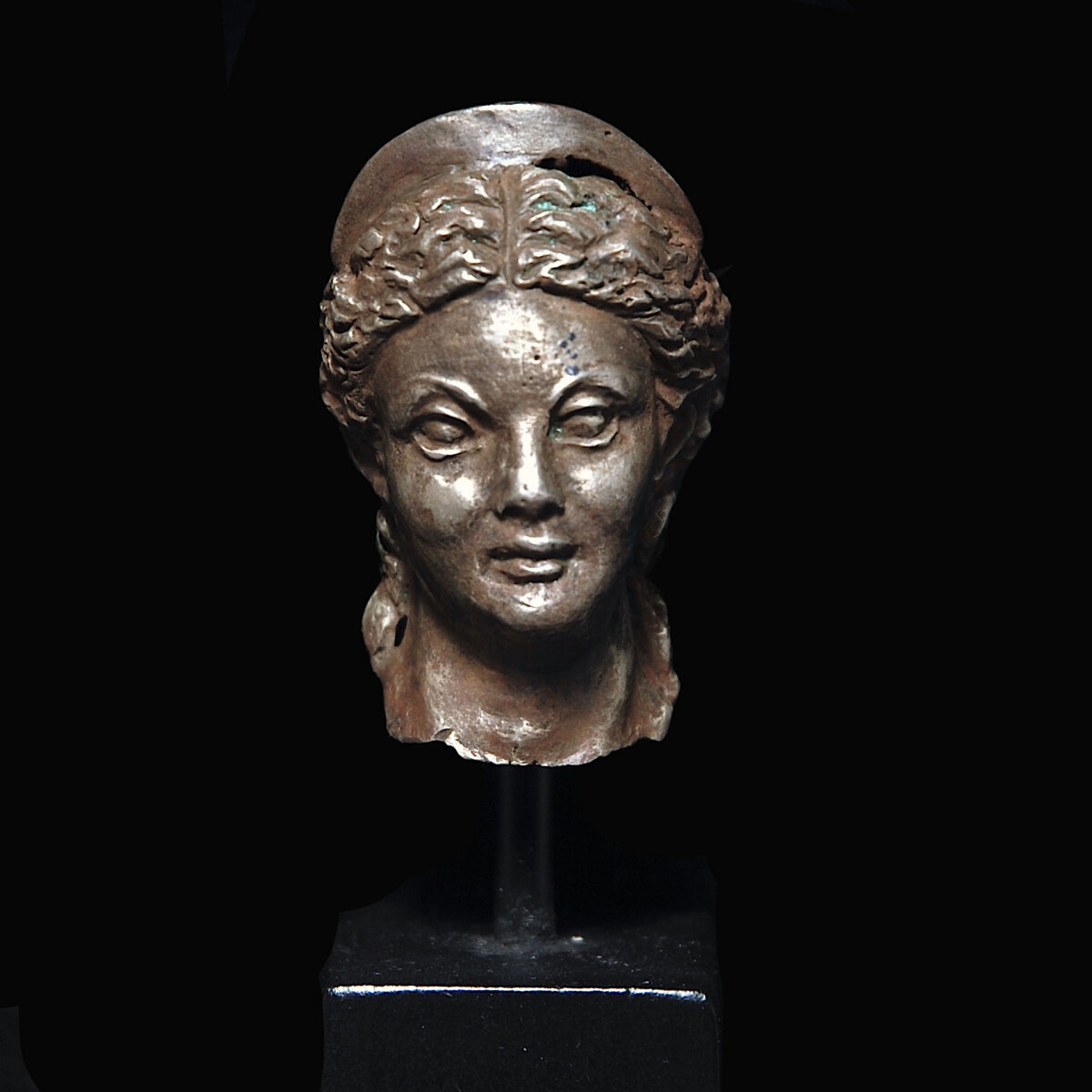
|
|
|
|
|
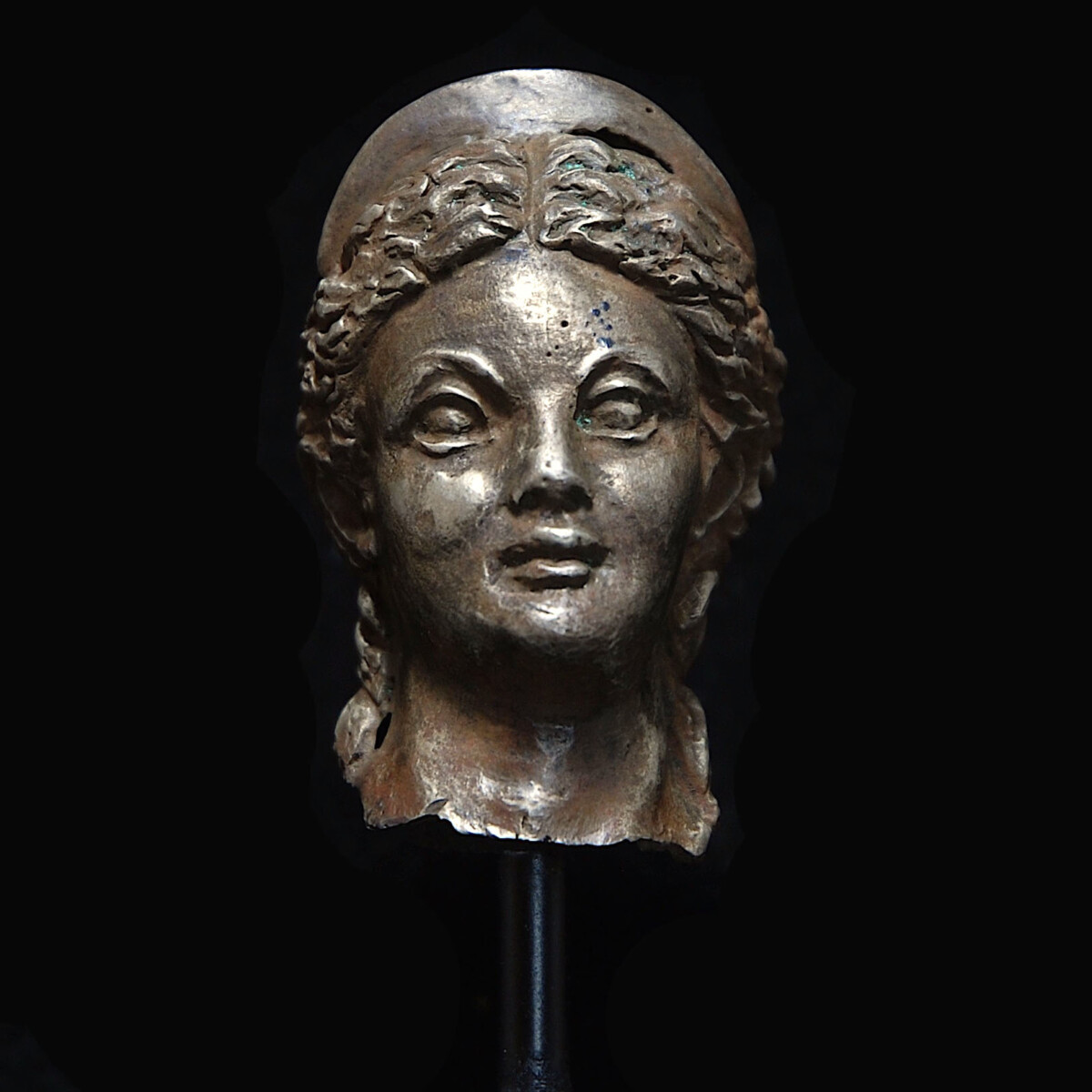
|
|
Greece – 2nd century B.C.
|
Masterly worked out, heavy silver head of Hera, wife of Zeus. The goddess with fine features, high cheekbones and a slightly open mouth, which indicates a smile. The eyes look awake from wide lids, the brows rise elegantly in a semicircle from the bridge of the nose. Hera has her wavy hair parted in the centre until the back of her head and pulled back. On the sides and at the back thick strands cascade to the nape. A high diadem crowns her head. See for the depiction the marble head of Hera in the Archaeological Museum in Tirana, Albania, as well as the famous Barberini Hera (or Juno) in the Museo Pio-Clementino in the Vatican. Both heads were modelled by Roman sculpturers based on a Greek original. The present silver head, which is dated around 300 years prior to the Barberini Hera, originates from a Greek workshop. It is not only exceptionally rare, but also of finest quality. Mounted.
|
Provenance: With Elie Borowski, Basel, Switzerland, prior to 1980. There acquired by Furman Hebb (1930-2021), New York.
Dimensions: 5.3 cm high
Price: 18 000 Euro
|
|
|
Griechenland – 2. Jahrhundert v. Chr.
|
Meisterhaft gearbeiteter, schwerer Silberkopf der Hera, Gattin des Zeus. Die Göttin mit feinen Gesichtszügen, hohen Backenknochen und einem leicht geöffneten Mund, der ein Lächeln erahnen lässt. Die Augen blicken wach aus breiten Lidern hervor, die Brauen erheben sich elegant halbkreisförmig vom Nasenrücken weg. Hera trägt das wellige Haar in der Mitte bis über den Hinterkopf gescheitelt und nach hinten gezogen. Seitlich und hinten fallen ihr dichte Strähnen in den Nacken. Ein hohes Diadem bekrönt ihren Kopf. Vergleiche zur Darstellung den Marmorkopf der Hera im Archäologischen Museum in Tirana sowie die berühmte Barberini Hera (oder Juno) im Museo Pio-Clementino im Vatikan. Beide Köpfe wurden von römischen Bildhauern nach einem griechischen Original gefertigt. Unser Silberkopf, der rund 300 Jahre vor der Barberini Hera datiert, stammt aus einer griechischen Werkstatt. Er ist nicht nur außergewöhnlich selten, sondern auch von feinster Qualität. Gesockelt.
|
Provenienz: Mit Elie Borowski, Basel, vor 1980. Dort erworben von Furman Hebb (1930-2021), New York.
Höhe: 5,3 cm
Preis: 18.000 Euro
|
|
|
|
Selected Artworks of the Month:
|
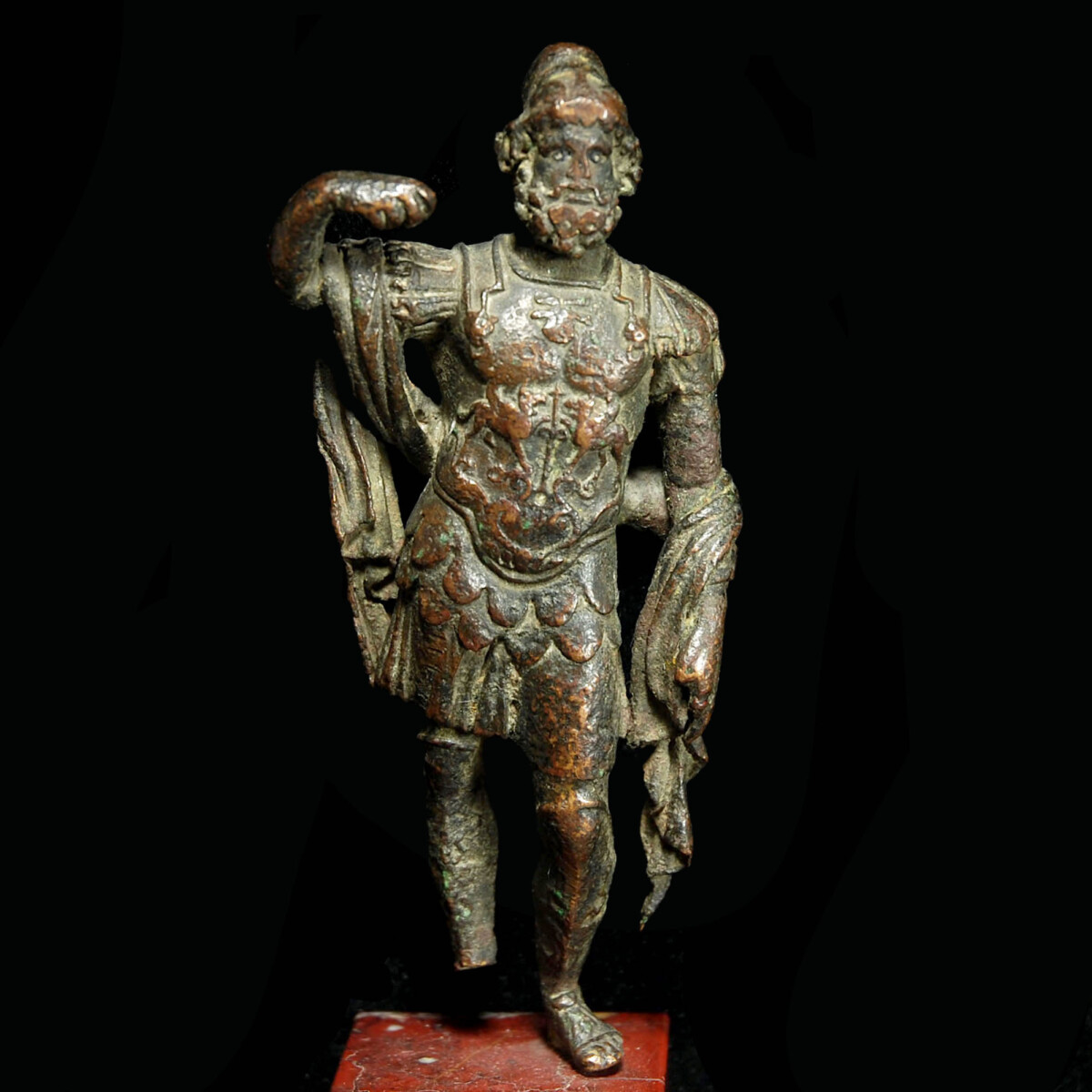
|
|
|
|
|
|
|
|
Roman Empire – 2nd century A.D.
|
Solid bronze statuette of Mars Ultor based on the model of the famous marble statue in the Capitoline Museum. The bearded god wears a Corinthian helmet, which he has pushed high over the forehead where his thick, wavy hair protrudes. His eyes are inlayed in silver. He wears greaves with straps around his calves. The abundantly decorated cuirass depicts two griffins flanking a thymiaterion under a gorgoneion. The winged creatures may allude to the fear inflicting weapons of Mars. The thymiaterion is associated with the eternal fire of Vesta, which stands for the stability of Rome. See for this interpretation the “Catalogue 10 Heads of Mars”, published by the Art Institute of Chicago. Beneath the cuirass the god wears the pteryges, a defensive skirt enforced with riveted metal fittings, which protects the pelvis area and whose rattle should intimidate the enemies. Mars has his right arm raised, which once held a separately worked out lance. Over the right shoulder, the back and the left arm he has thrown a pleated coat. Mounted.
|
Provenance: French private collection M. R., acquired in the 1970s to 1980s. Accompanied by a French antiquities passport.
Dimensions: 12.4 cm high
Price: 9 000 Euro
|
|
|
Römisches Reich – 2. Jahrhundert n. Chr.
|
Vollbronze-Statuette des Mars Ultor nach dem Vorbild der berühmten Marmor-Statue im kapitolinischen Museum. Der bärtige Gott trägt einen korinthischen Helm, den er hoch über die Stirn geschoben hat und unter dem das dichte, lockige Haar rundum hervorquillt. Seine Augen sind in Silber eingelegt. Er trägt Beinschienen, deren Riemen um seine Waden gebunden sind. Der reich dekorierte Brustpanzer zeigt zwei ein Thymiaterion flankierende Greifen unter einem Gorgoneium. Die geflügelten Wesen dürften auf die Schrecken verbreitenden Waffen des Mars anspielen. Das Thymiaterion wiederum wird mit dem ewigen Feuer der Vesta in Verbindung gebracht, das für die Beständigkeit Roms stand. Siehe zu dieser Interpretation „Catalogue 10 Head of Mars“, publiziert vom Art Institute of Chicago. Unter dem Brustpanzer trägt der Gott die Pteryges, ein mit aufgenieteten Metallbeschlägen verstärktes Kleidungsstück, das den Beckenbereich schützte und dessen Geklapper auf die Feinde einschüchternd wirken sollte. Mars hat den rechten Arm angehoben, der einst eine separat gefertigte Lanze hielt. Über die rechte Schulter, den Rücken und den herabhängenden linken Arm hat er einen faltenreichen Mantel geworfen. Gesockelt.
|
Provenienz: Französische Privatsammlung M. R., erworben in den 1970er bis 1980er Jahren. Mit französischem Antikenpass.
Höhe: 12,4 cm
Preis: 9.000 Euro
|
|
|
|
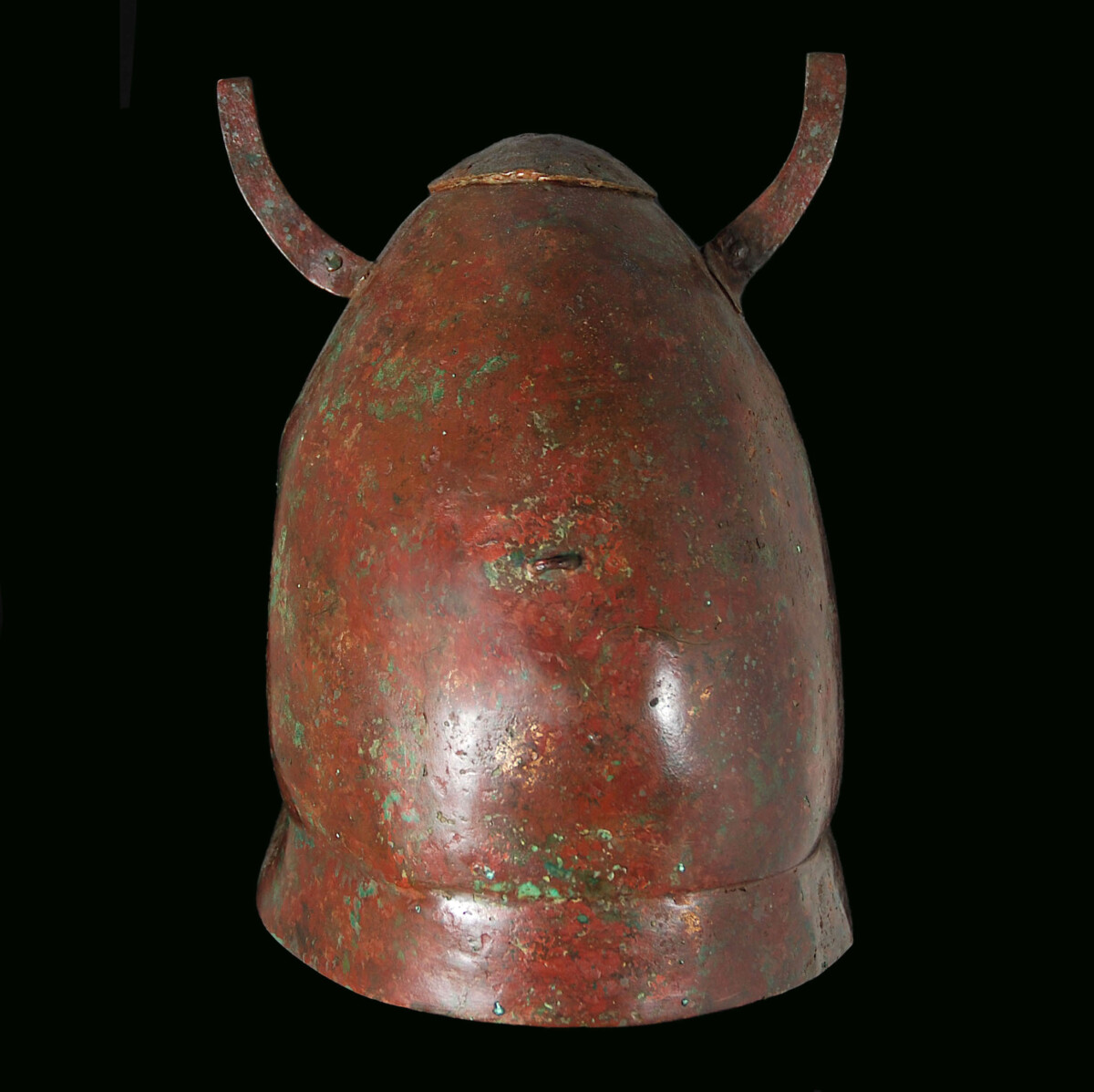
|
|
|
|
|
|
Greece – 4th-3rd century B.C.
|
Hellenistic Pilos helmet which was typical for the Alexander wars. The helmet with a high calotte and a narrow rim, set off by a bend. On top of the helmet a metal sheet for support, attached with four rivets, where three holes were pierced for mounting the plume. Left and right thereof riveted horns of bent bronze sheets. On the front and on the back of the helmet are two ring eyelets, possibly also to fix the crest. On each side, above the helmet rim a hole for fastening the chinstrap. Wonderful red-brown patina. Inside an old collection label “AG 537”, referring to the famous collection of Axel Guttmann. Mounted.
|
Provenance: Collection Axel Guttmann (1944-2001), acquired 1994 in Krefeld, Germany. Auctioned with Hermann Historica on 23 April 2009, lot 329. Last in the Gilles Grimm collection, France. Accompanied by a French antiquities passport.
Dimensions: 24.3 cm high
Price: 18 000 Euro
|
|
|
Griechenland – 4.-3. Jahrhundert v. Chr.
|
Hellenistischer Piloshelm wie er für die Alexanderkriege typisch war. Der Helm mit hoher Kalotte und schmalem, durch einen Knick abgesetzten Rand. Auf der Helmspitze ein mit vier Nieten aufgesetztes Blech zur Verstärkung, in das drei Löcher zur Befestigung des Helmbuschs gebohrt sind. Links und rechts davon aufgenietete Hörner aus gebogenen Bronzeblech. Auf der Vorder- und Rückseite des Helmes befinden sich zwei Ringösen, wohl ebenfalls um die Helmzier zu fixieren. Seitlich über dem Helmabsatz je ein Loch zur Anbringung des Kinnriemens. Herrliche rotbraune Patina. Innen das altes Sammlungsetikett „AG 537“, das auf die berühmte Sammlung Axel Guttmann verweist. Gesockelt.
|
Provenienz: Sammlung Axel Guttmann (1944-2001), erworben 1994 in Krefeld. Versteigert bei Hermann Historica am 23. April 2009, Los 329. Zuletzt in der Sammlung Gilles Grimm, Frankreich. Mit französischem Antikenpass.
Höhe: 24,3 cm
Preis: 18.000 Euro
|
|
|
|
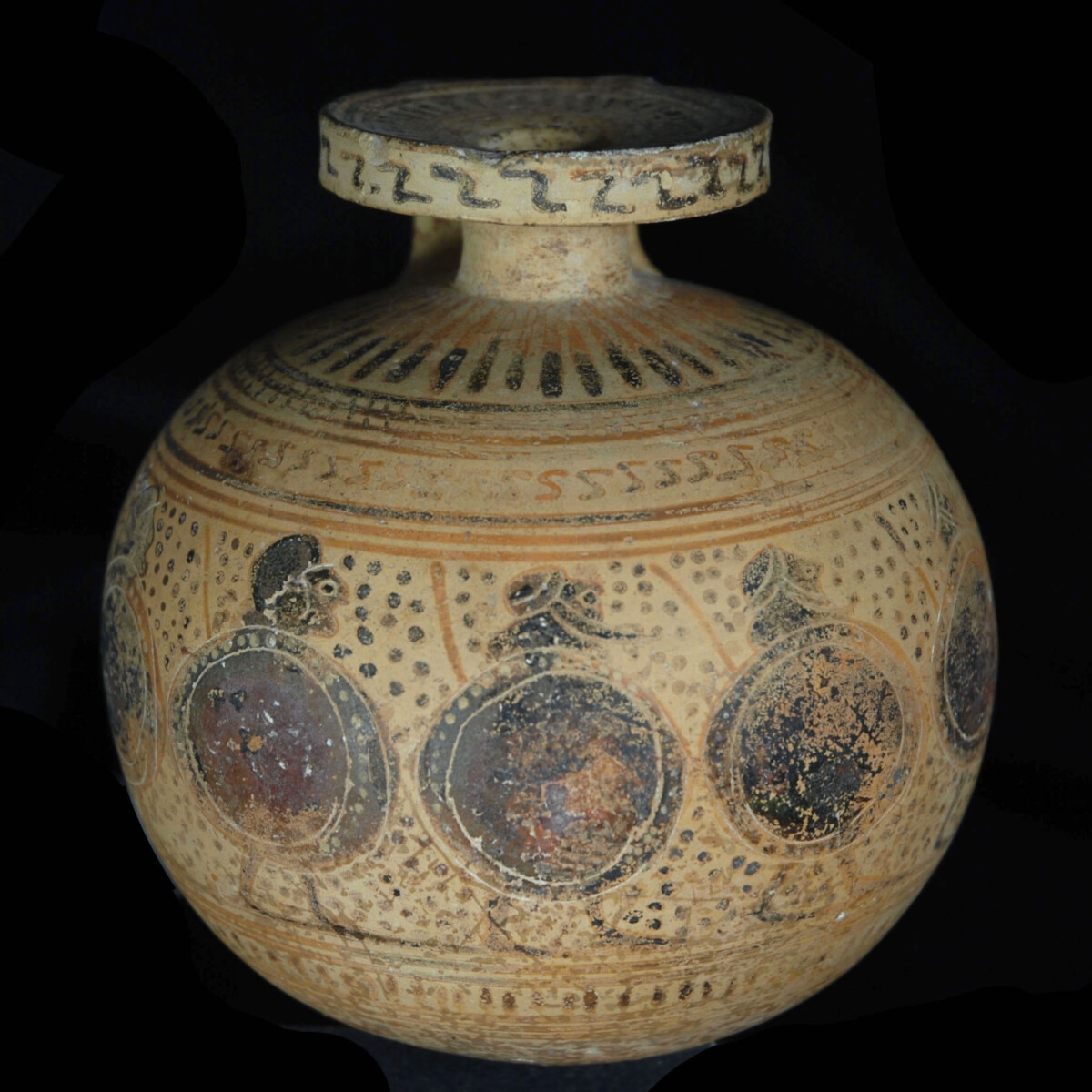
|
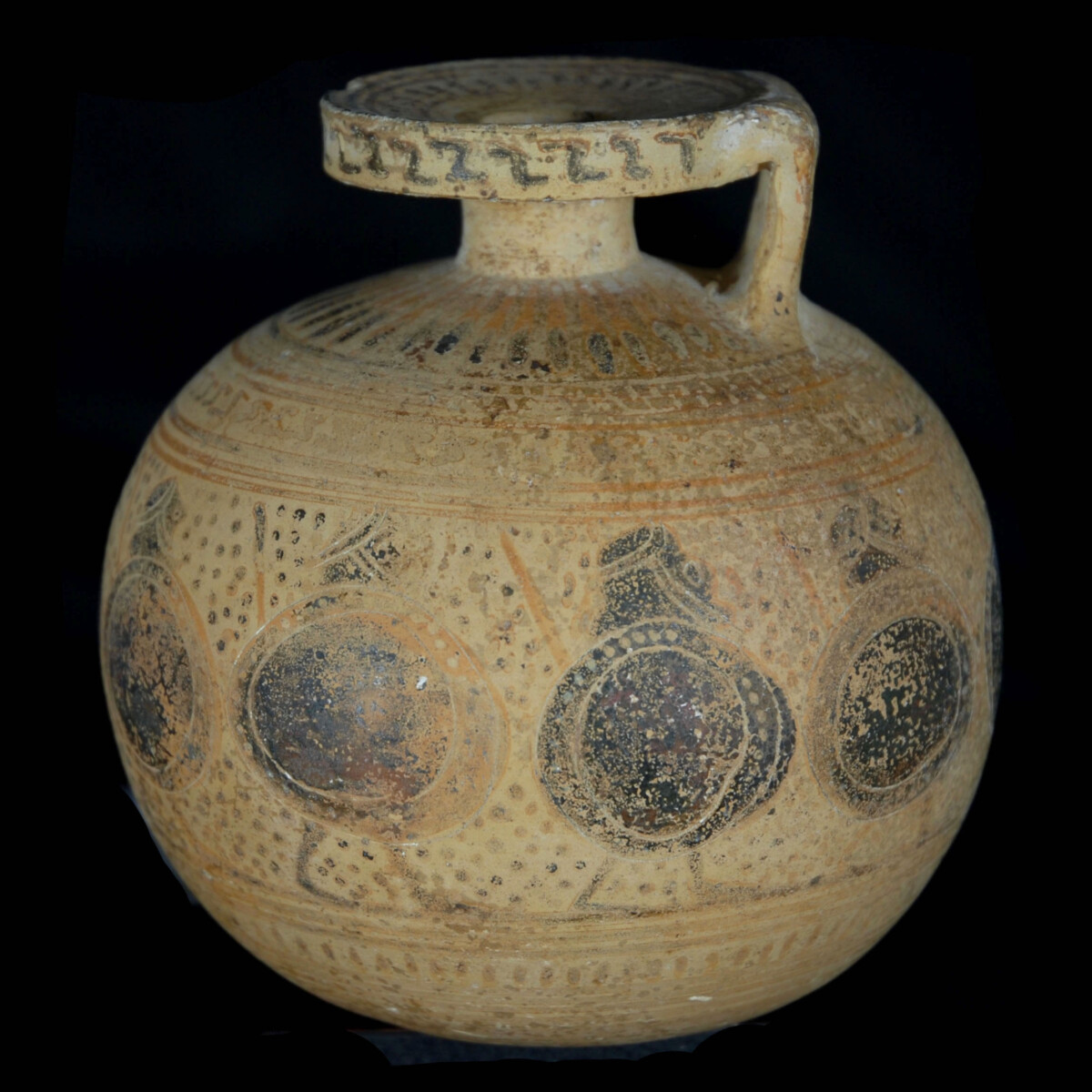
|
|
|
|
Greece/Corinth – 580-560 B.C.
|
Large Corinthian globular aryballos with a procession of striding hoplites to the right. The bearded stylized men wear helmets and hold large round shields and spears. The area between the figures are filled with dots. Above the procession red and brown bands, below a band of small, stylized water birds. From the neck towards the shoulder tongue decoration. The spout with a small round opening and a broad, horizontal rim is decorated on top with tongues. The base if flattened, in the centre a round dome inwards. A nearly identical aryballos was found in a sarcophagus in Elaious, a town at the southern entrance to the Hellespont, in 1923 and is now in the Louvre with accession number Éle 357.
|
Provenance: From an English collection 1970s to 1980s. With an old collection photo.
Dimensions: 12.5 cm high
|
|
|
Griechenland/Korinth – 580-560 v. Chr.
|
Großer korinthischer Kugelaryballos mit einer Prozession nach rechts schreitender Hopliten. Die bärtigen stilisierten Männer tragen Helme und halten große runde Schilder und Speere. Der Raum zwischen den Figuren ist dicht mit Punkten ausgefüllt. Über der Prozession rote und braune Bänder, darüber ein Band mit kleinen stilisierten Wasservögeln. Vom Hals Richtung Schulter Zungendekor. Der Ausguss mit kleiner, runder Öffnung und breitem, horizontalem Rand ist oben mit Zungen verziert. Der Boden abgeflacht, in der Mitte eine runde Wölbung nach innen. Ein nahezu identer Aryballos wurde 1923 in Elaious, einer Stadt am südlichen Eingang des Hellespont, in einem Sarkophag gefunden und befindet sich heute im Louvre mit der Accession number Éle 357.
|
Provenienz: Aus englischer Sammlung 1970er und 1980er Jahre. Mit altem Sammlungsfoto.
Höhe: 12,5 cm
Preis: 4.000 Euro
|
|
|
|
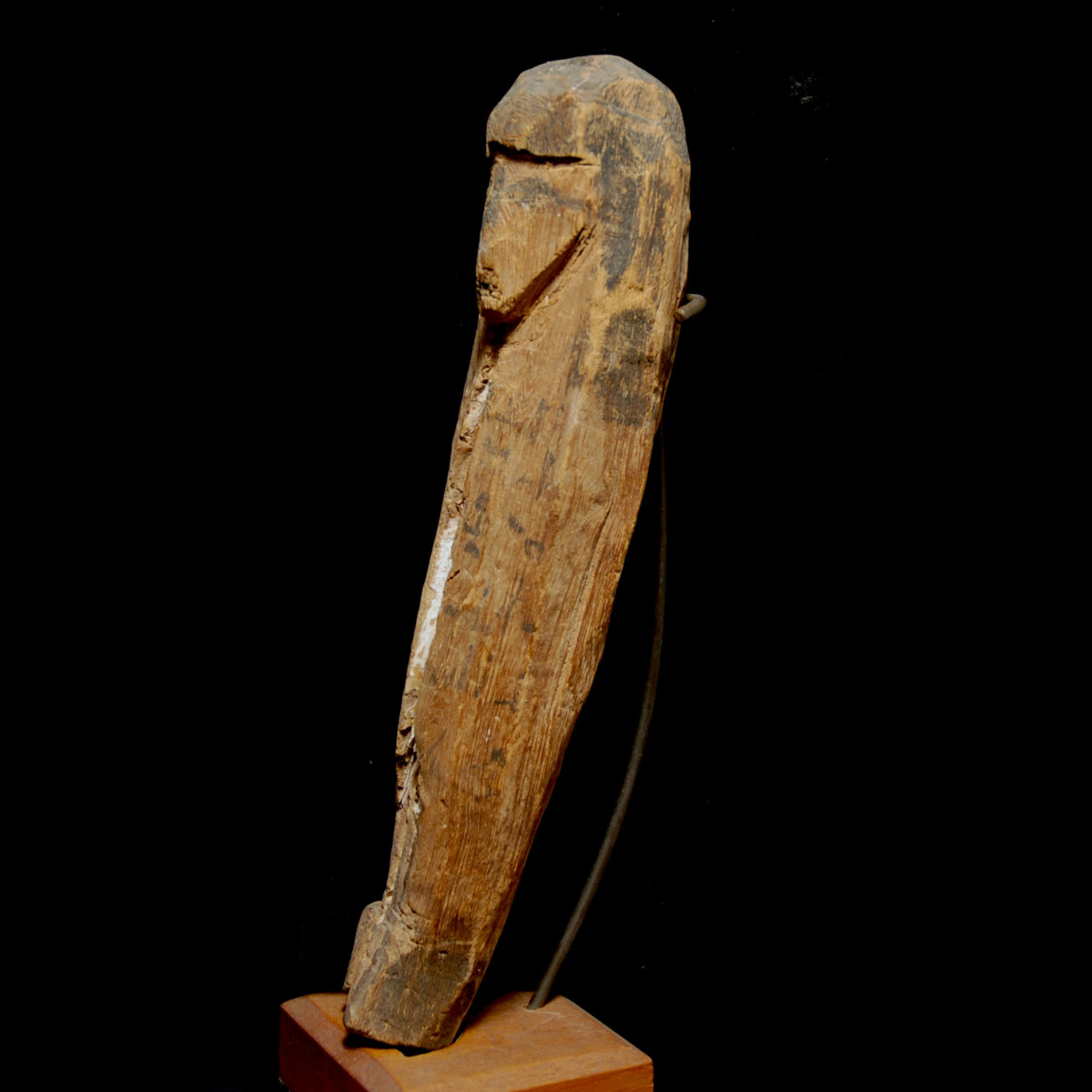
|
|
|
|
|
|
Egypt – 2nd Intermediate Period to early New Kingdom, 17th-18th dynasty, 1580-1292 B.C.
|
Rare, wood shabti, which is called "stick shabti" in literature. The roughly, in form of a stick, worked out statuettes were produced in the late 17th dynasty to the early 18th dynasty in Thebes. While regular shabtis were placed in the tombs and had functions, to work for the deceased, stick shabtis were always found in the aboveground cult chapel of Egyptian tombs. They represent family members and friends of the deceased, who should symbolically be close to him. This stick shabti has a v-shaped face with black painted eyes, nose, and mouth. It also has a black painted wig. The body is slightly bent and tapering towards the feet. A short kilt is worked out in relief at the back. At the front a hieratic inscription with the names of the owner and the founder is recognizable, which, however, can no longer be deciphered. The rare shabti is published in: Paul Whelan „Mere Scraps of Rough Wood? 17th- 18th Dynasty Stick Shabtis in the Petrie Museum and other Collections”, London 2007, pages 131 to 132. On an old wood base.
|
Provenance: Private collection Hugh Stanley Russell (1924-2000), acquired between the 1950s to 1970s. Auctioned with Bonhams London on 20 October 2005, lot 8. There acquired by the Egyptologist Paul Whelan, who published the shabti in 2007.
Dimensions: 20.8 cm high
Price: 6 600 Euro
|
|
|
Ägypten – 2. Zwischenzeit bis Anfang Neues Reich, 17.-18. Dynastie, 1580-1292 v. Chr.
|
Seltenes hölzernes Uschebti, das in der Literatur als „Stick-Shabti“ bezeichnet wird. Die grob, in Form eines Stabes gearbeiteten Statuetten wurden nur Ende der 17. und Anfang der 18. Dynastie in Theben hergestellt. Während herkömmliche Ushebtis in die Grabkammer gelegt wurden und die Funktion hatten, für den Verstorbenen zu arbeiten, wurden Stab-Shabtis immer in der oberirdischen Kultkapelle ägyptischer Gräber gefunden. Sie verkörpern wohl Familienmitglieder und Freunde des Verstorbenen, die diesem symbolisch nahe sein wollten. Dieses Stab-Uschebti hat ein keilförmiges Gesicht mit schwarz aufgemalten Augen, Nase und Mund. Es hat eine ebenfalls in Schwarz gehaltene Perücke. Der Körper ist leicht gebogen und verjüngt sich zu den Füßen hin. Ein kurzer Kilt ist im Relief hinten ausgearbeitet. Auf der Vorderseite ist eine sechszeilige hieratische Inschrift mit den Namen des Besitzers und des Stifters erkennbar, die jedoch nicht mehr entziffert werden kann. Das seltene Uschebti ist publiziert in: Paul Whelan „Mere Scraps of Rough Wood? 17th- 18th Dynasty Stick Shabtis in the Petrie Museum and other Collections”, London 2007, Seite 131 bis 132. Auf altem Holzsockel.
|
Provenienz: Privatsammlung Hugh Stanley Russell (1924-2000), erworben in den 1950er bis 1970er Jahren. Versteigert bei Bonhams London am 20. Oktober 2005, Los 8. Dort erworben vom Ägyptologen Paul Whelan, der es 2007 publizierte.
Höhe: 20,8 cm
Preis: 6.600 Euro
|
|
|
|
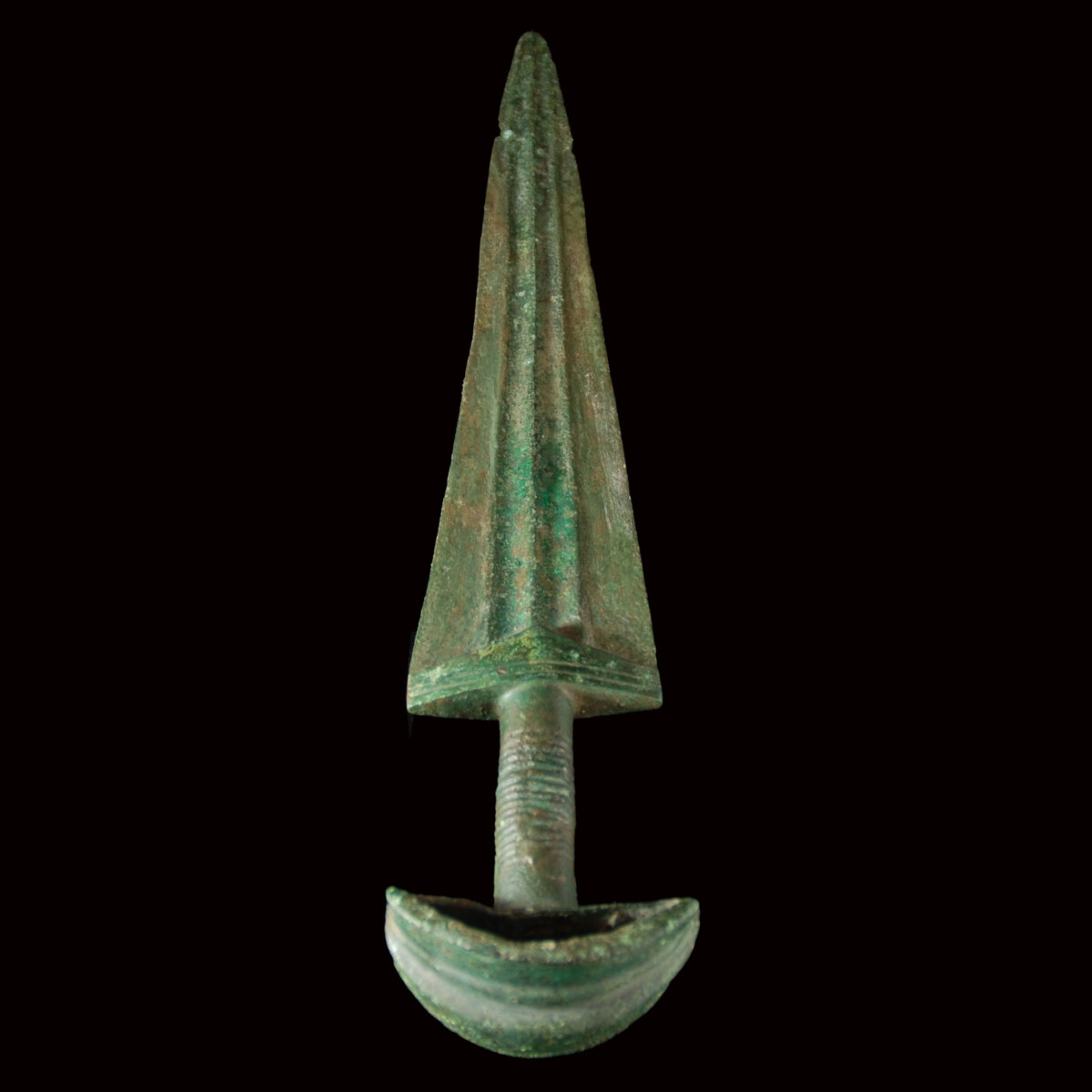
|
|
|
|
|
|
Iran/Luristan – 9th-8th century B.C.
|
Large bronze sword from Luristan with a massive triangular blade, on both sides with three strong ribs. The guard is trapezoid and at the lower end decorated with two indentations. The massive grip is grooved. Particularly striking is the semi-circular pommel which reaches across the width of the guard. It has a large midrib on the outside. An impressive, very massive sword from western Iran.
|
Provenance: From the old German collection R.S.
Dimensions: 57.8 cm long
Price: 4 800 Euro
|
|
|
Iran/Luristan – 9.-8. Jahrhundert v. Chr.
|
Großes Bronze-Schwert aus Luristan mit mächtiger dreieckiger Klinge, die auf beiden Seiten drei kräftige Rippen aufweist. Die Zwinge ist trapezförmig und am unteren Ende mit zwei Vertiefungen dekoriert. Der massive Griff ist gerillt. Besonders markant ist der halbrunde Knauf, der über die Breite der Zwinge hinausreicht. Er hat auf der Außenseite eine kräftige Mittelrippe. Ein beeindruckendes, sehr mächtiges Schwert aus dem westlichen Iran.
|
Provenienz: Aus alter deutscher Sammlung R.S.
Länge: 57,8 cm
Preis: 4.800 Euro
|
|
|
|
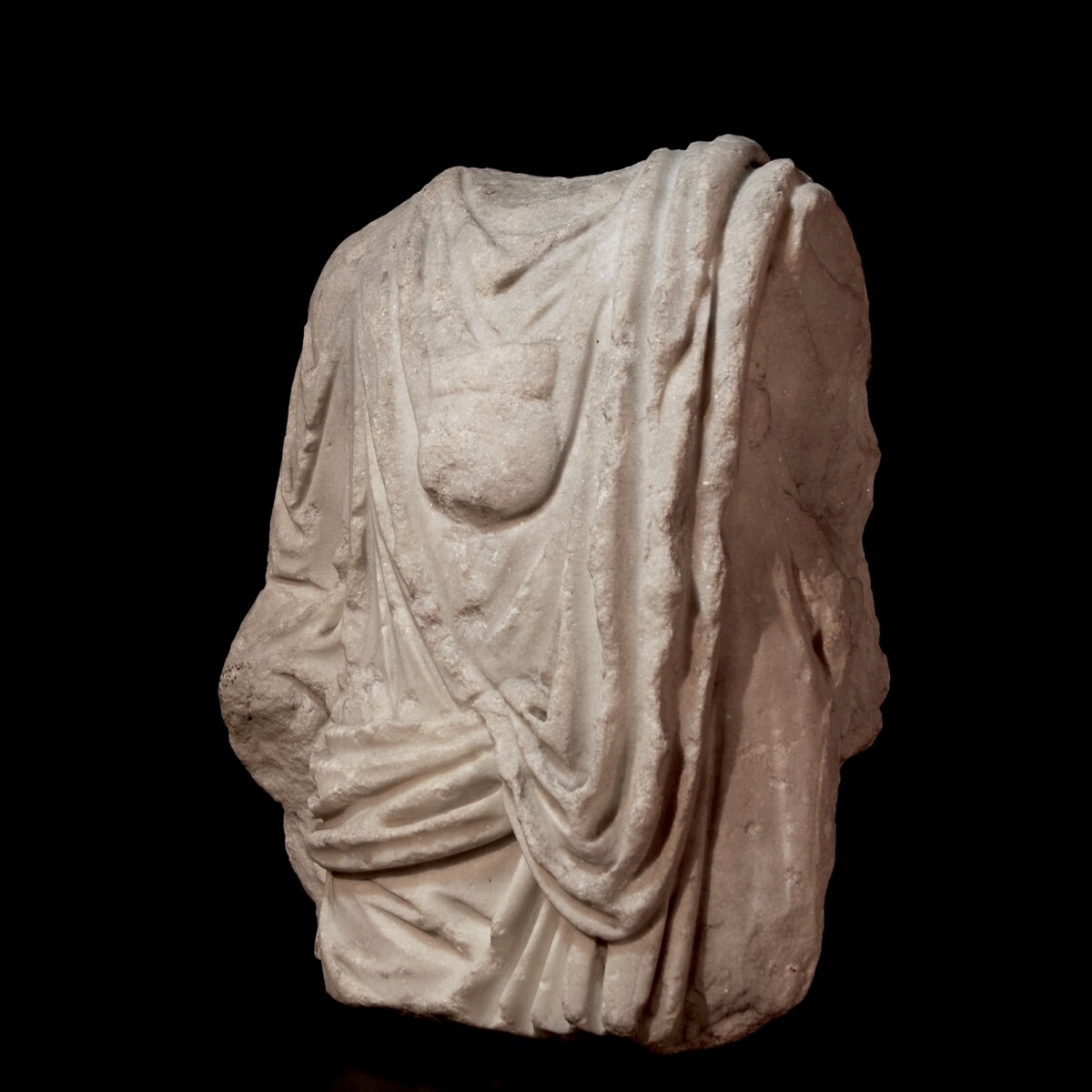
|
|
Roman Empire – 2nd century A.D.
|
Life-size statue fragment of a youth who wears a tunic under the long, voluminous toga (“Togatus”). The toga runs across the belly and is thrown over the left shoulder, where the end is tucked over the gathered horizontal part. The youth wears a bulla hanging on two bands around his neck. The Romans adopted from the Etruscans the tradition to, right after birth, put around children a bulla, which enclosed an amulet in the cavity, to protect against spell, especially the evil eye. The young boys only took off the bulla when they put on their toga virilis. The Romans adopted from the Etruscans the tradition to, right after birth, put around children a bulla, which enclosed an amulet in the cavity, to protect against spell, especially the evil eye. The young boys only took the bulla off once they put their toga virilis on.
|
Provenance: Private collection Nice, France. Accompanied by a French antiquities passport.
Dimensions: 45 cm high
Price: 14 000 Euro
|
|
|
Römisches Reich – 2. Jahrhundert n. Chr.
|
Lebensgroßes Statuenfragment eines Knaben, der eine Tunika unter einer langen, voluminösen Toga trägt („Togatus“). Die Toga verläuft horizontal über den Bauch und ist über die linke Schulter geschlagen, das Endstück ist dabei über den gerafften horizontalen Teil gesteckt. Der Knabe trägt eine auf zwei Bändern angehängte Bulla um den Hals. Die Römer übernahmen von den Etruskern den Brauch, Kindern unmittelbar nach der Geburt zur Abwehr von Zauber, vor allem des Bösen Blicks, eine Bulla umzuhängen, in deren Hohlraum sich ein Amulett befand. Knaben legten die Bulla erst mit dem Anlegen der Toga virilis ab.
|
Provenienz: Privatsammlung Nizza, mit französischem Antikenpass.
Höhe: 45 cm
Preis: 14.000 Euro
|
|
|
|
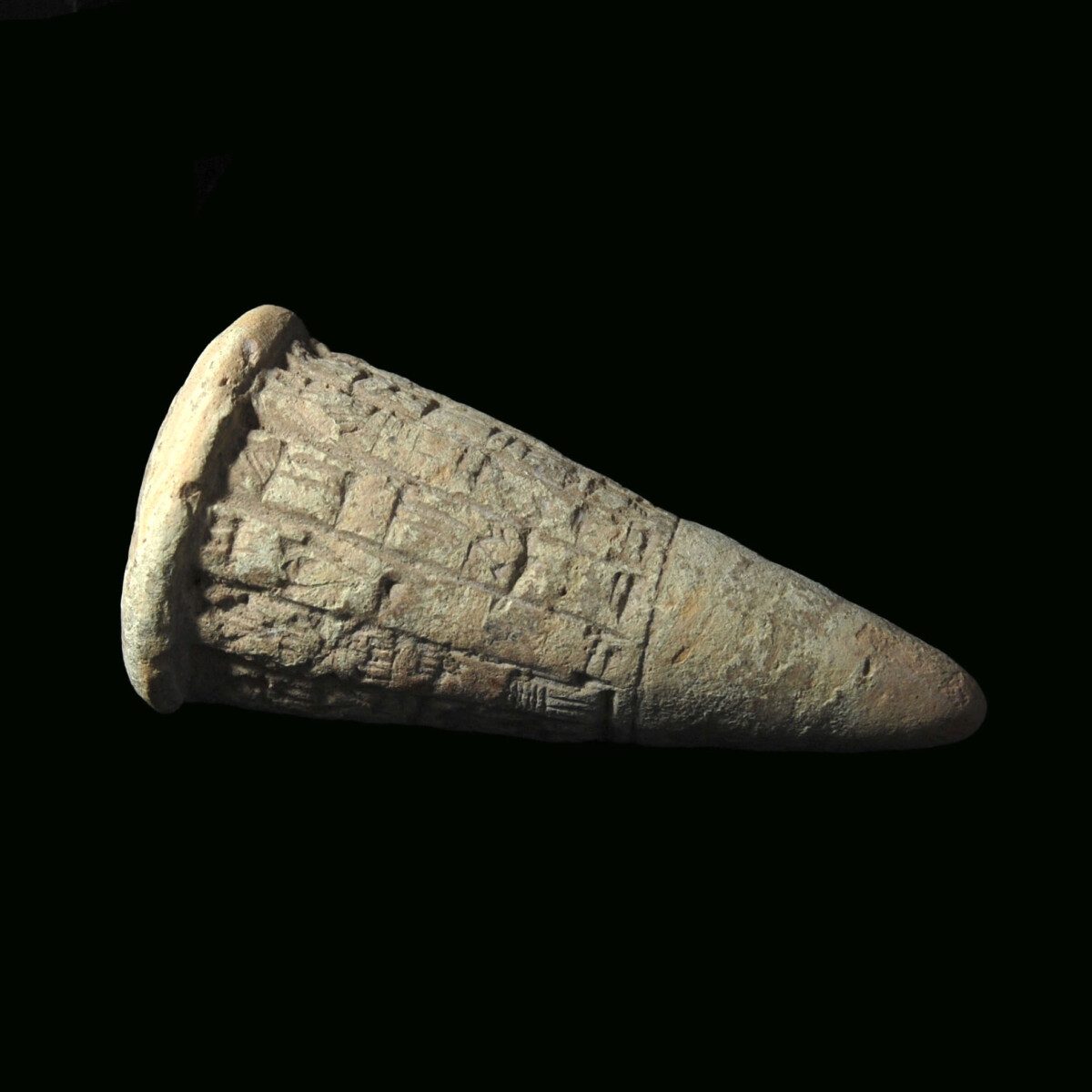
|
|
|
Completely preserved Sumerian foundation cone of light clay with 13 engraved columns. Twelve of these columns read an inscription which originate from Gudea, probably today the most famous ruler personality of the Mesopotamian history. As state-ruler of the Sumerian state Lagaš there are numerous inscriptions about him preserved on cylinders and cones. The text on the present foundation cone is a construction hymn, the translation reads: "Gudea, Ensi (state-ruler) of Lagaš, created magnificent, all fitting for Nin-gir-su (God), the fighter from Enlil, and built and renovated his E-ninnu (the temple of Nin-gir-su), the radiant Imdugud” (Sumerian description for Anzû, a creature of the Mesopotamian mythology, described as a lion-eagle). Nin-gir-su is associated with his father Enlil, the highest deity of the Sumerian Pantheon, and the pseudonym “Imdugud”, which is used to describe the E-ninnu temple, is an indication of his original form as God of the storms. Foundation cones such as the present one should also ensure the purity of the fundaments and protect from underground demons because the major temple from Lagaš establishes a cosmic connection between Heaven and Earth. See for the type the cone in the Musée des Beaux-Arts de Lyon with the inventory number 1943-26, as well as in the RISD Museum in Rhode Island, USA, with the object number 39.039.
|
Provenance: From the New Yorker private collection Steven Roday (1944-2009), acquired from the 1970s to the 1980s.
Dimensions: 12 cm long
Price: 2 200 Euro
|
|
|
Sumer – 2141-2122 v. Chr.
|
Komplett erhaltener sumerischer Gründungsnagels aus hellem Ton mit 13 gravierten Spalten. Zwölf dieser Spalten enthalten eine Inschrift, die von Gudea stammt, dem heute wohl bekanntesten Herrscher der Geschichte Mesopotamiens. Als Stadtfürst des sumerischen Staates Lagaš sind von ihm zahlreiche Inschriften auf Zylindern und Kegeln erhalten. Bei dem Text auf diesem Gründungsnagel handelt es sich um eine Bauhymne, die Übersetzung lautet: „Gudea, Ensi (Stadtfürst) von Lagaš, schuf Prächtiges, alles angemessen für Nin-gir-su (den Gott), den Kämpfer von Enlil, und baute und renovierte seinen E-ninnu (den Tempel des Nin-gir-su), der strahlende Imdugud" (sumerische Bezeichnung für Anzu, den Sturmvogel der mesopotamischen Mythologie, der als Löwenadler bezeichnet wird). Nin-gir-su wird mit seinem Vater Enlil, der höchsten Gottheit des sumerischen Pantheons, in Verbindung gebracht, und der Beiname „Imdugud“, der zur Beschreibung des E-ninnu-Tempels verwendet wird, ist ein Hinweis auf seine ursprüngliche Form als Gott der Stürme. Gründungsnägel wie dieser sollten auch die Reinheit der Fundamente garantieren und vor unterirdischen Dämonen schützen, da der große Tempel von Lagaš eine kosmische Verbindung zwischen Himmel und Erde herstellte. Vergleiche zum Typus den Nagel im Musée des Beaux-Arts de Lyon mit der Inventarnummer 1943-26 sowie jenen im RISD Museum in Rhode Island, USA, mit der Objektnummer 39.039.
|
Provenienz: Aus der News Yorker Privatsammlung Steven Roday (1944-2009), erworben in den 1970er bis 1980er Jahren.
Länge: 12 cm
Preis: 2.200 Euro
|
|
|
|
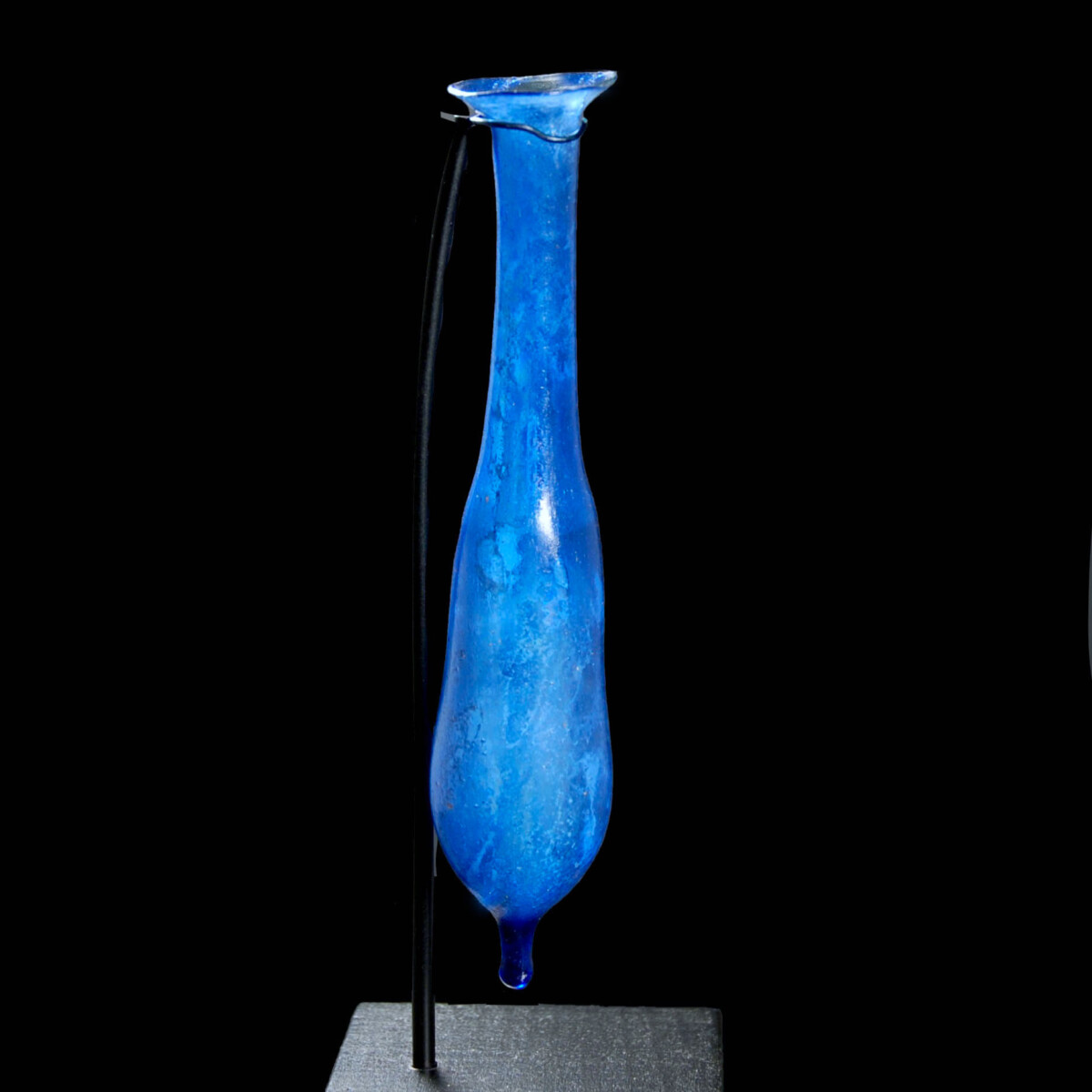
|
|
|
|
Roman Empire – 1st century A.D.
|
Rare, tapering unguentarium of blue clear glass with a funnel-shaped spout and a long, cylindrical neck. The corpus is bulbous and in the centre slightly indented. The base is drop-shaped elongated. Mounted.
|
Provenance: Private collection Dr. Eugene Elovic, Miami Beach, USA. Thence Israeli art market.
Dimensions: 13.5 cm high
Price: 2 200 Euro
|
|
|
Römisches Reich – 1. Jahrhundert n. Chr.
|
Seltenes, spitz zulaufendes Unguentarium aus blauem Klarglas mit trichterförmigem Ausguss und langem, zylindrischen Hals. Der Korpus bauchig und mittig leicht eingezogen. Der Boden hängt tropfenförmig herab. Gesockelt.
|
Provenienz: Privatsammlung Dr. Eugene Elovic, Miami Beach, USA. Danach im israelischen Kunsthandel.
Höhe: 13,5 cm
Preis: 2.200 Euro
|
|
|
|
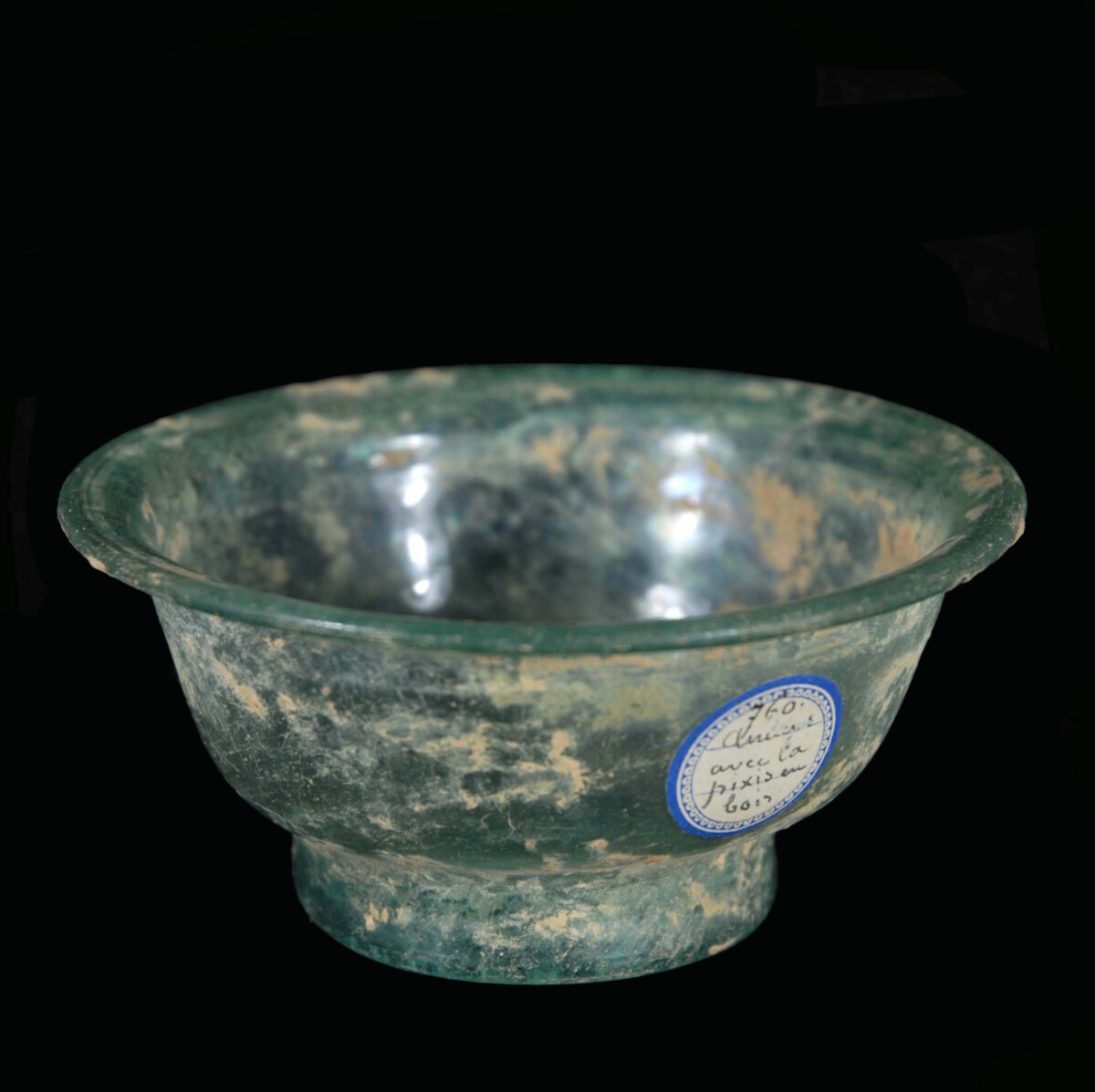
|
|
|
|
Roman Empire – Late 2nd century A.D.
|
Cup of greenish clear glass with a horizontally, far protruding rim. The edge of the rim is folded back. The wall of the cup is straight and tapering downwards. The vessel stands on a foot ring pulled out from the wall. On the side an old collection label with the inscription "760. Arivée avec la pixis en bois".
|
Provenance: From the private collection of the French archaeologist Louis-Gabriel Bellon (1819-1899). For over 120 years in a family estate.
Dimensions: 10.3 cm diameter
Price: 1 200 Euro
|
|
|
Römisches Reich – Ende 2. Jahrhundert n. Chr.
|
Schale aus grünlichem Klarglas mit horizontalem, weit nach außen gezogenem Rand. Der Randabschluss ist unten kurz zurückgefalten. Die Wand der Schale ist gerade und verjüngt sich nach unten. Das Gefäß steht auf einem aus der Wandung gezogenen Standring. Seitlich ein altes Sammlungsetikett mit der Aufschrift: „760. Arivée avec la pixis en bois“.
|
Provenienz: Aus der Privatsammlung des französischen Archäologen Louis-Gabriel Bellon (1819-1899). Seit über 120 Jahren in Familienbesitz.
Durchmesser: 10,3 cm
Preis: 1.200 Euro
|
|
|
|
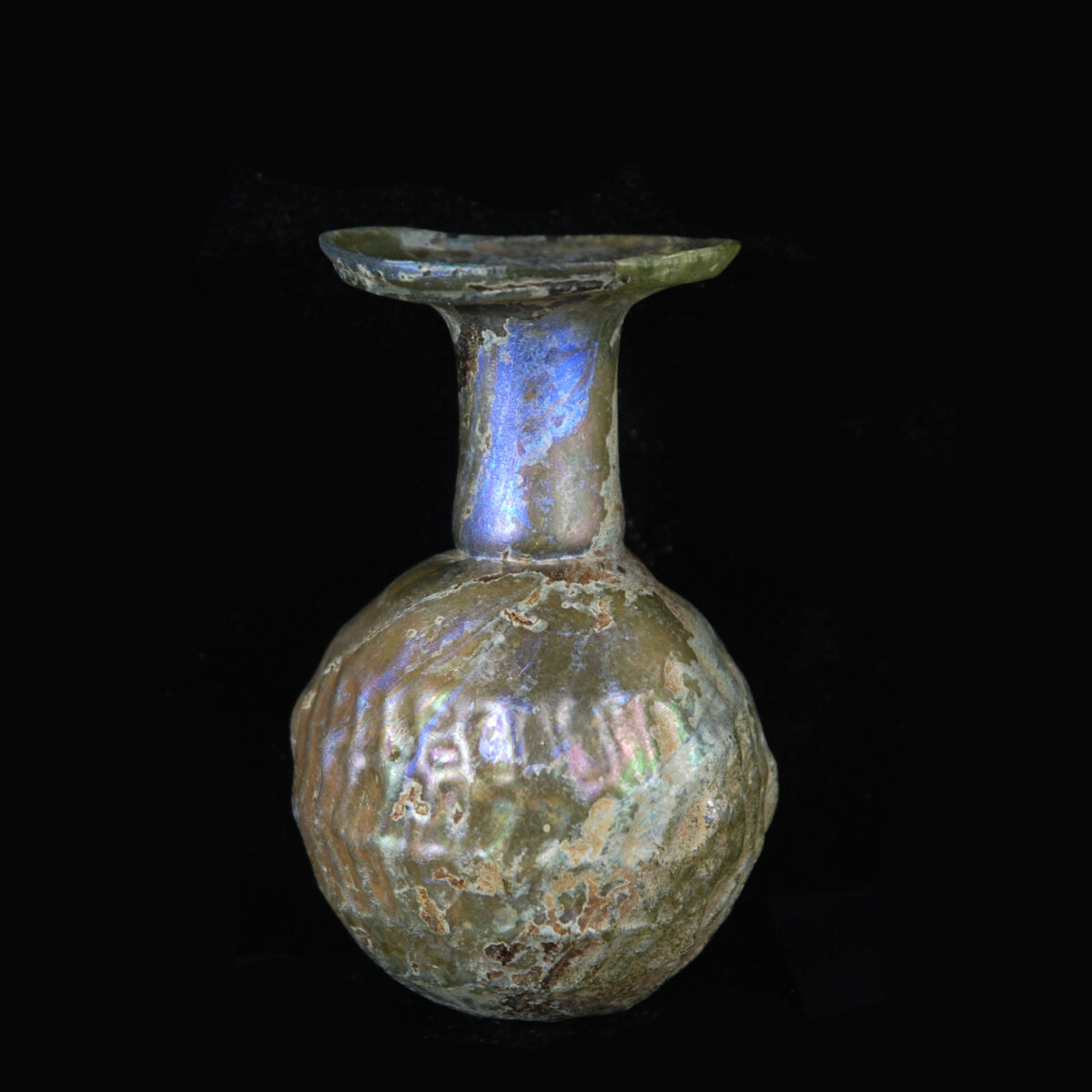
|
|
Roman Empire – 3rd century A.D.
|
Roman sprinkler with a bulbous corpus blown into shape. The outside is decorated with a zig-zag pattern. The rim is far protruding outwards, the end is rounded. The neck is cylindrical and slightly constricted towards the corpus. Inside, the neck is divided by a folded partition, which only has a small round opening. So the precious liquid, which this glass once held, could be poured out drop by drop. With a beautiful blue-violet iridescence. At the bottom remains of the rib. See for the type: “Römisches, byzantinisches und frühmittelalterliches Glas – Sammlung Ernesto Wolf”, Hatje Cantz 2001, numbers 130 to 132.
|
Provenance: German collection P.R., acquired between 1970 and 1990.
Dimensions: 8.8 cm high
Price: 800 Euro
|
|
|
Römisches Reich – 3. Jahrhundert n. Chr.
|
In die Form geblasener römischer Sprenkler mit kugeligem Korpus. Die Außenseite ist mit einem Zickzack-Muster verziert. Der Rand ist sehr weit nach außen gebogen, der Abschluss heiß verrundet. Der Hals ist zylindrisch und am Ansatz zum Korpus leicht eingeschnürt. Innen ist der Hals durch eine gefaltete Trennwand unterbrochen, die nur eine kleine runde Öffnung besitzt. So konnte die wertvolle Flüssigkeit, die dieses Glas einst fasste, Tropfen für Tropfen ausgegossen werden. Mit wunderbarer blau-violetter Irisierung. Unten Reste der Heftnarbe. Vergleiche zum Typus: „Römisches, byzantinisches und frühmittelalterliches Glas“ – Sammlung Ernesto Wolf“, Hatje Cantz 2001, Nummer 130 bis 132.
|
Provenienz: Deutsche Sammlung P. R., erworben zwischen 1970 und 1990.
Höhe: 8,8 cm
Preis: 800 Euro
|
|
|
|
|
|
|
CHRISTOPH BACHER ARCHÄOLOGIE ANCIENT ART GmbH
|
Galerie: Stubenring 20, A-1010 Wien
Showroom: Untere Viaduktgasse 55, A-1030 Wien
|
|

|
|
|
|